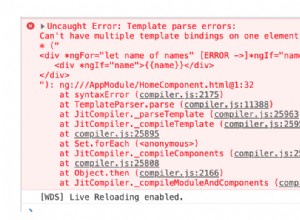我如何理解打字稿中的協變和逆變
協變、逆變、雙變……這些詞對你來說似乎陌生,難以理解?
我向你保證,在本文的最後,所有這些都會讓你更清楚。
什麼是?
當您使用類時,一個類可以擴展到另一個類。例如:
class Animal {}
class Dog extends Animal {}
class Greyhound extends Dog {}
這意味著兩件重要的事情:
-
狗 是一個
subtype動物 和動物 是supertype狗 . -
狗 是
supertype灰狗 和灰狗 是subtype狗
不錯不錯?
我們現在可以理解協變、逆變和雙變的定義了!
協方差:
協方差接受 subtype 但不接受 supertype
我們可以採用一個只接受 covariant 的函數 Dog 的類型
const acceptDogCovariance = function (value: Covariant<Dog>) { ... }
acceptDogCovariance(new Animal()) // Error, since Animal is a supertype of Dog
acceptDogCovariance(new Dog()) // Ok
acceptDogCovariance(new Greyhound()) // Ok since Greyhound is a subtype of Dog
逆變:
逆變接受 supertype 但不接受 subtype
const acceptDogContravariance = function (value: Contravariance<Dog>) { ... }
acceptDogContravariance(new Animal()) // Ok, since Animal is a supertype of Dog
acceptDogContravariance(new Dog()) // Ok
acceptDogContravariance(new Greyhound()) // Error since Greyhound is a subtype of Dog
雙變量:
雙變量接受兩者,supertype &subtype !
所以現在我們學習了定義,但是它在 Typescript 中是如何工作的?特別是對於 function
Typescript 如何對函數中的參數使用協變和逆變?
一個合法的問題,不是嗎?
在打字稿中,參數類型是 bivariant !實際上這不是 correct 行為,但為什麼呢?
好的好的,我們將說明這個unsound 案子 !
class Animal {
doAnimalThing(): void {
console.log("I am a Animal!")
}
}
class Dog extends Animal {
doDogThing(): void {
console.log("I am a Dog!")
}
}
class Cat extends Animal {
doCatThing(): void {
console.log("I am a Cat!")
}
}
function makeAnimalAction(animalAction: (animal: Animal) => void) : void {
let cat: Cat = new Cat()
animalAction(cat)
}
function dogAction(dog: Dog) {
dog.doDogThing()
}
makeAnimalAction(dogAction) // TS Error at compilation, since we are trying to use `doDogThing()` to a `Cat`
在一個例子中,我們可以證明參數類型的 Bivariance 是 unsound ,但不要難過我們可以解決這個問題,感謝 Typescript 2.6 你只需要使用 --strictFunctionTypes 在你的 Ts 配置中標記。
所以 makeAnimalAction 需要是 contravariant 對於參數類型。多虧了這一點,我們可以避免對 Cat 進行 Dog 動作!
function makeAnimalAction(animalAction: (animal: Animal) => void) : void {
let cat: Cat = new Cat()
animalAction(cat)
}
function animalAction(animal: Animal) {
animal.doAnimalThing()
}
makeAnimalAction(animalAction) // "I am a Animal!"
Typescript 如何對函數中的返回類型使用協變和逆變?
Typescript中函數的返回類型是covariant !
感謝您閱讀此內容.....好吧,我將嘗試演示它!
class Animal {}
class Dog extends Animal {
bark(): void {
console.log("Bark")
}
}
class Greyhound extends Dog {}
function makeDogBark(animalAction: (animal: Animal) => Dog) : void {
animalAction(new Animal()).bark()
}
function animalAction(animal: Animal): Animal {
return animal
}
makeDogBark(animalAction) // Error since not all Animal can bark.
這裡我們需要有一個 Dog 或一個 subtype makeDogBark 的返回類型中的 Dog 爭論。所以返回的類型需要是 covariant
TL;TR &結論
所以在 Typescript 中,參數類型需要是 contravariant 並且函數類型需要是 covariant 在他們的返回類型中。
我希望你喜歡這篇文章!
🎁你可以得到我的新書Underrated skills in javascript, make the difference 如果你在 Twitter 上關注我並 MP 我 😁
或者在這裡獲取
🎁 我的時事通訊
☕️你可以支持我的作品🙏
🏃♂️你可以關注我👇
🕊 推特:https://twitter.com/code__oz
👨💻 Github:https://github.com/Code-Oz
並且你可以標記🔖這篇文章!
我使用 https://www.stephanboyer.com/post/132/what-are-covariance-and-contravariance 來理解和解釋這篇文章




